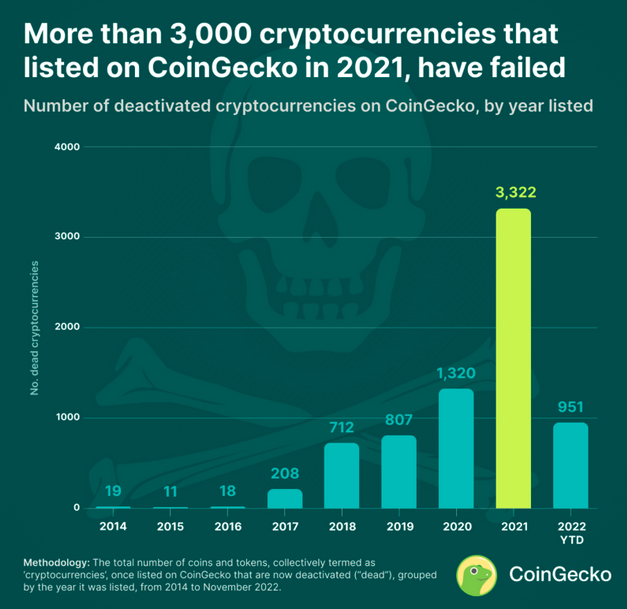CoinGecko compiled dead token data on its platform since 2014, showing that 2021 was the biggest year for deactivated coins, coming in with 3,322 projects folding.
Unusually, deep within crypto winter, the number of dead tokens for the current year is significantly fewer than the prior year, at 951.

947 dead crypto projects expected per year
As the bull market was picking up pace in 2021, more than 8,000 projects in total were listed on CoinGecko. However, currently, “nearly 40% have been deactivated and delisted” since then.
“This is 2.5 times higher than the amount of cryptocurrencies listed in 2020 that failed, and 3.5 times higher than 2022 YTD.”
Explaining the significant rise in dead coins in 2021, the platform apportioned blame on “‘meme coin season” which was prevalent during the mania of last year.
At this time, many projects sprung up with anonymous dev teams offering investors “little to no value.” These projects often failed due to being fly-by-night cash grabs with low commitment from the devs.
Currently, there are 13,130 coins listed on CoinGecko, significantly more than the 8,000 in 2021. Yet 2022 showed significantly fewer projects folding. This suggests the launching of meme coins is not as pervasive this year compared to the last.
However, it is worth noting that CoinMarketCap currently lists a total of 21,903 tokens. As such, CoinGecko data does not give a complete overview of the market.
CoinGecko labeled 2021 an “anomaly year.” Excluding 2021 data, i.e. for the data set 2018, 2019, 2020, and 2022, an average of 947 crypto projects die per year.
The methodology used
To determine whether a crypto token was dead or deactivated, CoinGecko looked at whether the token:
- had zero trading activity within the last 2 months.
- was revealed as a scam or rug pull via news or direct reports from verifiable sources.
- or the project had requested deactivation.
The latter happens when the team disbands, rebrands, shutters the project, or undergoes major token changes to the point the old token becomes illiquid or dead.
 cryptoslate.com
cryptoslate.com